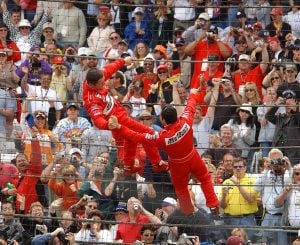INDIANAPOLIS — Twenty years ago, on what memory tells me was the Wednesday before the 2003 Indy 500, I was sitting at a departure gate at the Fort Lauderdale-Hollywood Int’l Airport, waiting on a flight to Indianapolis, when up walked a couple of business travelers.
Ten days earlier, Team Penske drivers Helio Castroneves and Gil de Ferran had qualified for the big show. They’d spent the next week or so fine-tuning race setups. Then they rested, jetting to south Florida, where both of them had homes. Now they began their return trip, arriving at the airport early and waiting with the herd for all to see.
And no one batted an eye. As far as I could tell, I was the only person in that seating area, maybe in the entire airport, who had any idea who they were.
Castroneves was the 500’s two-time defending winner. De Ferran had won the IndyCar series title in 2000 and ’01. They were two of the sport’s leading men and they worked for a team with the best PR staff in the business, yet there they sat, in total anonymity. If ever a moment symbolized Indy car racing’s disconnect with the American public, this was it.
 The NASCAR boom was at full roar and the contrast between the two series was severe. If Jeff Gordon, Mark Martin or Tony Stewart ran through that airport, people would have left their shoes and carry-on luggage at the security gate to give chase.
The NASCAR boom was at full roar and the contrast between the two series was severe. If Jeff Gordon, Mark Martin or Tony Stewart ran through that airport, people would have left their shoes and carry-on luggage at the security gate to give chase.
To steal a phrase from Joni Mitchell, stock car racing’s star maker machinery was working perfectly. Rarely did a driver get to the Cup Series unless he’d had a distinguished career in the short-track minors. He might have driven late models, sprint cars, midgets or modifieds; he might have been a fresh-faced phenom like Gordon or a grizzled 40-something like Dick Trickle.
What mattered was that he had built a name and a fan base. When the name reached the big time, the fan base came with it.
NASCAR had great drivers for whom fans would travel, bleed and cheer themselves hoarse. Indy car racing had great drivers who were admired, but not quite loved.
Generally speaking, fans root for heroes they relate to, heroes whose backstories ring true. In an earlier age of Indy car racing, that meant the likes of A.J. Foyt, son of a garage owner from blue-collar Houston; Mario Andretti, a child of immigrants who sailed to these shores in search of the American dream; and Bobby and Al Unser, wildcat brothers from Albuquerque. Those guys, like their NASCAR counterparts, reached the big leagues as known quantities. Newspaper headlines had trumpeted their dirt-track exploits, and the same folks who’d cheered them at the bullrings now cheered them at Indianapolis, Phoenix and Trenton.
But in the ’80s and ’90s, when CART was the Indy car sanctioning body, road courses steadily displaced ovals. Naturally, the marquee rides in the series were soon filled with road racers. Some were Europeans and South Americans whose Formula 1 dreams dissolved; others had cut their teeth domestically in small-bore formula cars, often competing in what were billed as “non-spectator events.” You can see how it might be tough for a driver to build a following when officials outnumber fans.
In time, CART’s starting grids were peppered with names that Americans never fully connected to. That’s not xenophobia; it’s just a fact, borne out by Indy car racing’s spotty crowds and dismal TV ratings. Its own star maker machinery grew rusty from disuse.
Which brings us back to that Fort Lauderdale airport scene. In a few days, de Ferran and Castroneves would sweep the top two finishing positions in the biggest single-day sporting event in the world, but for now they might have been a couple of insurance salesmen flying to a seminar.
I used to think that it had to get better, that Indy car racing’s leaders, team owners and sponsors would see what had worked for NASCAR. Not so much. Instead, two decades later we see NASCAR’s leaders, team owners and sponsors bizarrely heading down the same trail that put Indy car racing in the ditch.
No, the two scenarios aren’t exact copies. CART’s myopic team owners hired unknown drivers for their road-course speed, which made sporting sense if not good business sense. NASCAR’s slide started several years ago when its bosses, chiefly Brian France, set off on a pursuit of all things youthful, braying about young drivers and a younger fan base.
Memo to Jim France, Ben Kennedy and anyone else with their shoes beneath a desk in Daytona Beach: The most enduring scenario in motorsports is Newcomer vs. Established Champion. For examples, see Jeff Gordon vs. Dale Earnhardt, Darrell Waltrip vs. Cale Yarborough or, going back to a brief war in Big Bill France’s day, Bobby Allison vs. Curtis Turner.
Each time, the newcomer established his value by beating the established champ. That formula helped build NASCAR, and still works at scores of Saturday-night tracks.
Stack the field with newcomers and, without enough established champions to measure them against, you’ll never know for sure how good any of them are.
Tune into a Cup Series race these days and you see fields dotted with drivers whose quality remains unproven. Team owners love them, because these kids work cheap. But look past the former champions and a small handful of youngish guys — Christopher Bell, Erik Jones, Ryan Preece, Ricky Stenhouse and a few more — with exceptional short-track credentials. Of the remaining drivers, how many arrived in the NASCAR Truck, Xfinity or Cup Series garages with real fan support? Even those who won races and titles in a feeder series didn’t stay anywhere long enough to pull the masses to their sides.
So, having failed to notice or heed the sad example set by Indy car racing, NASCAR finds itself facing a hard question: Are its fans ready to travel for, bleed for and cheer themselves hoarse for drivers they don’t know much about?
This story appeared in the April 5, 2023 edition of the SPEED SPORT Insider.

